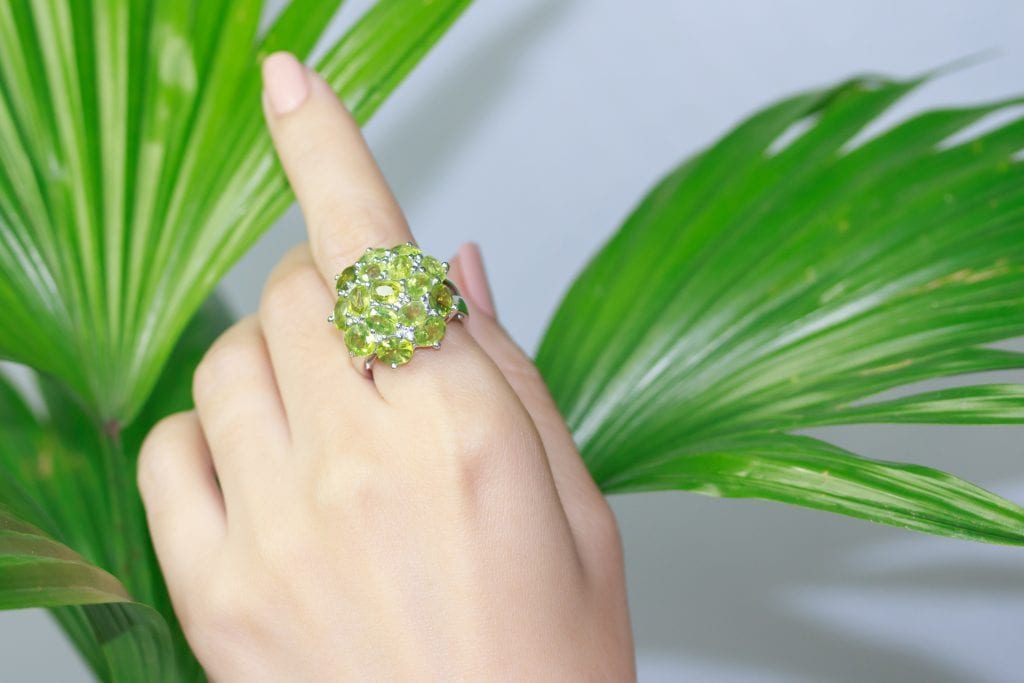The fresh lime green of peridot is its distinctive signature. It has been found in ruins of ancient Egypt and Greece and was often called the evening emerald by ancient Romans, who noticed that its green color shone even more vividly in the lamplight, making it resemble deep green emeralds. Most ancient peridot probably came from the Red Sea island of St. Johns, which produced highly prized dark-green peridot.
While emeralds are usually the most popular gemstones that come in green, Peridot is considered the “evening emerald” for its olive tinge and more subtle hue. While all types of jewelry can be made from Peridot, because of the stone’s softness rings should be worn with care. If you are looking for a less known, but extremely beautiful rare green gemstone, you can’t do much better than Peridot.
The prices and value of Peridot can vary tremendously, depending on the size and quality of the gemstone. AJS Gems is your source for the highest quality Peridot and many other precious colored stones from across the globe, available at Bangkok direct wholesale prices. Creating the finest jewelry starts with finding the best gemstones, and the best gemstones are found at AJS Gems.
Why Buy Loose Gemstones Instead of Pre-Set Jewelry?
There are many reasons, but mainly it comes down to value and choice…
When buying your Peridot as a loose gemstone instead of pre-setting, you can be sure that you are getting the best value for your money. Loose gemstones are less expensive, a better value, and you can really see what you are paying for. The most important part of getting the right price and finding the best value is to first see what you’re getting. A jewelry setting will hide the inclusions inside a gem and can deepen or brighten its color. With a loose stone, you can much more easily inspect the gem and see it for what it really is. In this way, you can get a better idea of its true worth and be sure you are paying a fair price.
The second advantage of buying a loose gemstone is choice. You are free to pick the exact color, cut, shape, and variety of the stone for the setting of your dreams, be it yellow gold, white gold, platinum or silver; prong-set or bezel set with diamond accents. You can experience the joy of creating your very own, one-of-a-kind jewelry design. Choose from a variety of jewelry settings and styles to create a completely original presentation that will perfectly suit your individual gemstone and will be as unique as you are!


At AJS Gems, you will find a large collection of fine quality Peridot gemstones from Burma, Pakistan, and China.
| Origin | U.S.A. (most notably Arizona), Australia, Brazil, China, Kenya, Mexico, Myanmar (Burma), Norway, Pakistan, South Africa, Sri Lanka, Saudi Arabia, and Tanzania |
|---|---|
| Color | Green, yellowish-green, dark lime green and brownish-green. |
| Refractive Index | 1.64-1.70 |
| Chemical Composition | (MgFe)2SiO4 |
| Hardness | 6.5 – 7 |
| Density | 3.2-4.3 |
| Crystal Structure | Orthorhombic |
| Zodiac Sign | Libra |
| Anniversary | 16th |
Peridot belongs to the forsterite-fayalite mineral series which is part of the olivine group. It is one of the “idiochromatic” gems, meaning its color comes from the basic chemical composition of the mineral itself, not from minor impurities, and therefore will only be found in shades of green. Peridot is an Iron Magnesium Silicate with the fine traces of iron being responsible for its green coloration. The intensity of the color is dependant upon the amount of iron in the stone. Because of the way peridot splits and bends the rays of light passing through it, it has a velvety, “sleepy” appearance – a shining rich glow, and a slightly greasy luster.
Peridot has a refractive index of 1.64 to 1.70 and a vitreous surface luster. The refractive index (RI), measured using a refractometer, is an indication of the amount light rays are bent by a mineral. Birefringence is the difference between the minimum and the maximum RI. When birefringence is high, light rays reflect off different parts of the back of a stone causing an apparent doubling of the back facets when viewed through the front facet.
Most gems have a crystalline structure. Crystals have planes of symmetry and are divided into seven symmetry systems. The number of axes, their length, and their angle to each other determine the system to which a crystal belongs. Peridot crystallizes in the orthorhombic crystal system.
Color
Peridot is one of the few gemstones that comes in only one color. The depth of green depends on how much iron is contained in the crystal structure and varies from yellow-green to olive to brownish-green. The slightly golden shimmering green variety is an ideal color to complement a light summertime outfit. Vivid lime-green peridot with no olive tones is most popular. The fresh lime green of peridot is its distinctive signature. The color of most gems is caused by traces of other elements but the color of peridot is an integral part of its structure. If you love citrus tones or earth tones, you’ll find that peridot is an integral part of your jewelry wardrobe. Its spring green color also is ideal with sky blue.
Cut
Treatments
Occasionally Peridots are enhanced with colorless oils or resins which reduce the visibility of the inclusions and improve the clarity of the stone. It is also known to occasionally improve the color.
The Red Sea island of St. Johns was an important source of peridot in earlier times. It was rediscovered about a century ago and still produces small quantities of the gemstone. Peridot Mesa, on the San Carlos Apache Indian Reservation in Arizona, is an important source of peridot. It is mined by Native Americans. Although not mined commercially, peridot can also be found at several different locations in New Mexico. Mines in Pakistan and China yield large amounts of peridot.
Mythology
The name Peridot is derived from the Greek word ‘Peridona’ which when translated means ‘giving plenty’.
It was thought that peridot brought power and influence to its owner.
Over the years, peridot has been considered a healing stone that could help lungs, heart, spleen, stomach ulcers, intestines, and even eyesight.
Associated with the sun, peridot supposedly had the power to drive away all darkness and evil spirits.
Peridot is said to bring good luck, fortune, and peace. It is also said to attract love, calm anger, and protect against negative emotions. Peridot brings protection, health, and peaceful sleep.
In Hawaii, peridot symbolizes the goddess Pele’s tears. Some Hawaiian beaches are packed with tiny grains of peridot that are too small to cut.
In the Middle Ages, people wore peridot to gain foresight and divine inspiration as well as to protect them against evil.
Ground peridot, taken internally, was once used as a treatment for asthma.
Source: https://www.ajsgem.com/gemstone-information/peridot-84.html


